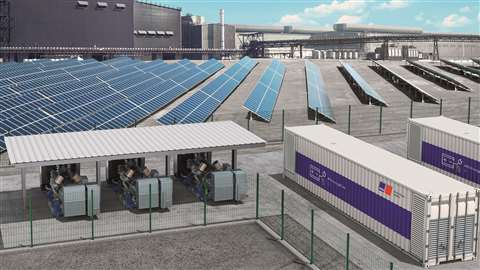Rolls-Royce and microgrids: Q&A with Andreas Görtz
18 April 2023
There is no one-size-fits-all solution in microgrid applications, says Andreas Görtz, president of Sustainable Power Solutions, Rolls-Royce. Görtz recently took part in a question-and-answer session with Diesel Progress to discuss the current microgrid market, how microgrids fit into decarbonization efforts and the challenge of balancing renewable energy supplies.
 Andreas Görtz, President of Sustainable Power Solutions, Rolls-Royce. (Photo by Rolls-Royce)
Andreas Görtz, President of Sustainable Power Solutions, Rolls-Royce. (Photo by Rolls-Royce)
Question: We’ve gone through periods where the concept of microgrids, or distributed power, was seen as significant trend. Looking back into the 1990s and early 2000s, it didn’t fully materialize. What’s different now?
Answer: The increasing amount of renewable energy and the need for secure power generation is one trend. Second is that all these off-grid power generation units (on islands, mine sites, etc.) have a clear trend to reduce CO2 emission and therefore go for a combination of renewables, storage and gas or diesel as backup. A third trend is a goal to become independent from grids where electricity prices are going up in an uncontrolled manner and power security is becoming weak.
Q: How do you see microgrids helping achieve decarbonization, both short and long term?
A: For an island where electricity is actually produced by dirty HFO (heavy fuel oil) power stations, a move to renewable plus storage and diesel as back-up reduces emissions at least by 60%, depending on the harvesting factor of the renewable power and the storage capacity. Short term massive expansion in renewable power should always go in parallel with building storage capacity. Hence, a wind park with a huge BESS (battery energy storage systems) and a black start capability is de-coupling the volatile renewable energy from the grid. This helps to better align demand and production peaks, which often have a miss-match. Such a combined installation is a large scale microgrid.
Q: The ability to balance various energy sources – renewables (wind/solar), battery storage and engines – isn’t easy. Adding the complexity of the control technology with the redundancy required by the intermittency of renewables and the rather high price of energy storage, doesn’t that all have the potential to limit the growth of microgrid applications just because of cost?
 Rolls-Royce will provide an integrated mtu microgrid solution for new 2MW energy centre at Symmetry Park Biggleswade, UK. (Photo by Rolls-Royce)
Rolls-Royce will provide an integrated mtu microgrid solution for new 2MW energy centre at Symmetry Park Biggleswade, UK. (Photo by Rolls-Royce)
A: Yes, microgrids are more complex and do need smart controls in order to optimize the use of microgrids and to run them with lowest possible OPEX. The combination of renewables with storage in any electricity market where renewables become dominant is a must. Technology-wise, there are different options, from pump storage schemes over BESS to hydrogen production. We should be technology agnostic, but the balancing between production and demand side is needed. You can see in countries like UK and Germany for example how many GW of electricity production of wind and solar cannot be used because the grid is too weak or the demand is not enough to take the potentially generated power.
Q: What is the biggest challenge for microgrid adoption? Technology or regulatory?
A: Frankly speaking, it is a sometimes regulation (approval of sites), not much technology. But very often, there is a difficulty to deal with the complexity of microgrids. This dealing with complexity is a challenge on the supplier side as well as on the customer side. In other words, if you are familiar with selling as well as operating a gas-fired power station, to add solar and BESS in order to reduce gas consumption adds complexity, which has to be managed.
Q: Is there any ideal type of application or installation suitable for a microgrid? How much flexibility is there in the design layout of an mtu microgrid?
A: Since a microgrid is not a product, but the smart combination of products into a solution, microgrids can be operated in Western Australia as well as in North Carolina. What’s important is the choosing the right configuration of products in order to ensure an optimal operation of the microgrid when it comes to total cost of ownership, reliability and availability. The most complex are off-grid microgrids with very demanding island grids, such as industrial plants with large consumers and high starting currents.
 According to Andreas Görtz, president of Sustainable Power Solutions, Rolls-Royce, a microgrid isn’t one product, but the integration of products into a solution specific for the application and location. (Photo by Rolls-Royce)
According to Andreas Görtz, president of Sustainable Power Solutions, Rolls-Royce, a microgrid isn’t one product, but the integration of products into a solution specific for the application and location. (Photo by Rolls-Royce)
Q: One scenario that’s been suggested is that in a microgrid, you might use the renewable part to power a hydrolyzer to create green hydrogen that could be used to power the engine generator set. Again, could that add to the complexity and cost of the installation? Or could you eliminate the energy storage piece and just use the renewable part to act as a fuel source for the gen-set?
A: As mentioned before, storage of electricity in an energy market where renewables are dominating is a must. Of course, the storage of electricity as electricity is the most economical option, but there are limits. We actually see a maximum storage of four hours with Lithium Ion batteries as an economical limit. Pumping water up a mountain and letting it flow back into turbines has an efficiency of approximately 80%. But areas where this technology can be used are limited. So the production of green hydrogen by means of electrolyzer, storing it and re-powering if needed is a viable option for longer-term storage of renewable energy. Here we do see decentralized solutions advantageous due to faster deployment, less infrastructure needed and higher efficiencies.
POWER SOURCING GUIDE
The trusted reference and buyer’s guide for 83 years
The original “desktop search engine,” guiding nearly 10,000 users in more than 90 countries it is the primary reference for specifications and details on all the components that go into engine systems.
Visit Now
STAY CONNECTED




Receive the information you need when you need it through our world-leading magazines, newsletters and daily briefings.
CONNECT WITH THE TEAM








